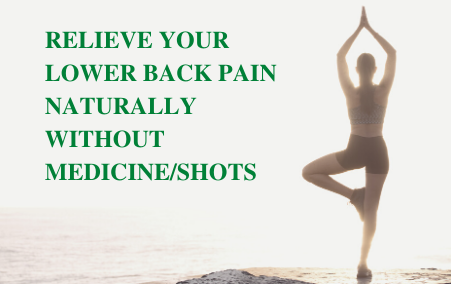Lower back pain management
Are you sick of lower back pain controlling your life? In this article, you learn about lower back pain management and how to relieve your back pain naturally with conservative methods and exercises.
Low back pain is a very common condition. About 80% of adults experience back pain at some point of time in their life. Good news is most of the time the back pain goes away on its own in two to six weeks. In some cases it can stay longer or can occur recurrently.
Among the different types of back pain mechanical/non-specific back pain is most common. Origin of this type of pain includes strain, trauma, poor health, poor posture, lack of physical activity.
Poor postures or movements burden lower back:
Prolong sitting in a desk chair without good lumbar support is the very common reason seen these days in population working in front of computer. Standing for long period of time without proper weight distribution in both legs burdens back muscles. Repeated bending, frequent and repeated turning and twisting creates overuse injury. Heavy lifting without proper bio mechanics create tension in the back. Apart from these common reasons ssmoking, overweight, physically strenuous work, anxiety, stressful or dissatisfying job are the common factors that may increase chances of getting back pain.
Staying active is the most effective way to relieve and prevent back pain. Physical therapy helps to relieve back pain naturally without medicine or injection and reduces healthcare monetary burden. Healthcare providers recommend physical therapy first than any other intervention for lower back pain management in conservative way which is cost effective way too.
Performing aerobic exercises like walking, swimming, stationary bicycle, along with stretching and strengthening exercises, provide great benefit to recover faster. Exercise too soon in the recovery phase may worsen the symptoms. It is recommended to talk to your physical therapist to learn which exercises are good to start with to avoid re-injury to muscles.
Things to do at home to relieve back pain:
Rest is important; however, research shows that physical activity during recovery has more benefits over resting. Therefor, staying active is much important. Ice pack for 15-20 min for every 2-3 hours over the area of discomfort. Use it for 24-72 hours after first episode of pain, and after that start using hot packs. Add natural supplement like turmeric in your diet. Learn here how turmeric/curcumin has potential to reduce back pain naturally. Practice good postures in the office and daily activities as it helps to reduce stress on muscles and spine.
Benefits of exercises:
It improves the blood circulation and thus reduces inflammation and speeds up healing process, strengthens core muscles and improves posture. Exercise increases stamina, reduces weight and keeps back healthy and strong.
Now you know the importance of exercise in lower back pain management, it is recommended to perform exercises with a specialist’s supervision; however, if you are performing exercises at home and still do not see any improvement, or if your lower back pain persists for more than few days or becomes worse, schedule an appointment with Physical Therapy to start your care.
Learn here how physical therapist can help you to relieve your lower back pain naturally without medicine/shots.
Here are few stretching exercises you can do at home to relieve lower back pain.
About Potential Physical Therapy:
Our physical therapist designs a personalized exercise program according to individual needs. We use an evidence-based approach to educate and treat you in a way that speeds up your recovery. We also teach proper forms of exercises along with manual therapy, electrotherapy modalities for faster recovery. In most of the cases physical therapy will be enough to recover from lower back pain.
Contact Potential Physical Therapy today to learn more about our services and how they can help you relieve pain.
Reference:
https://medlineplus.gov/ency/article/002119.htm

